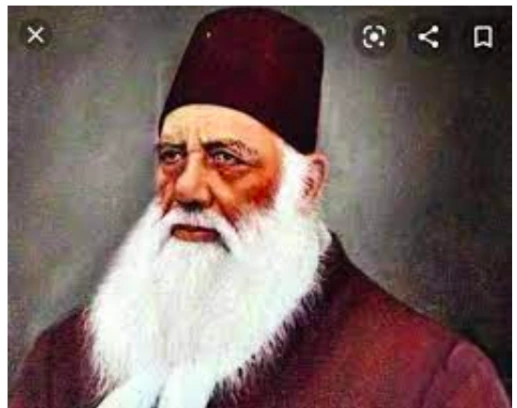Answer:
Approach:
- Introduction: Begin with the context of socio-cultural changes in 19th century India, setting the stage for the emergence of reformers. Introduce Sir Syed Ahmad Khan as a key figure during this transformative period.
- Body:
- Segment the main content into two critical areas of Sir Syed Ahmad Khan’s reformative contributions: educational reforms and bridging cultural divides.
- Educational Reforms:
- Discuss the establishment of the Mohammedan Anglo-Oriental College.
- Highlight Sir Syed’s advocacy for scientific learning and modern education.
- Illustrate how Sir Syed used education as a mechanism for broader social reform.
- Bridging Cultural Divides
- Explain Sir Syed’s efforts in fostering dialogue between Indians (especially Muslims) and the British, including his initiatives like “Tahzibul Akhlaq.”
- Discuss his role in promoting political participation and legal empowerment among the Muslim community.
- Mention his stance on socio-economic issues and gender equality to showcase the breadth of his reformist vision.
- Conclusion: Conclude by reinforcing the enduring relevance of his cautionary message about the critical role of learning and cultural enrichment in national development
|
Introduction:
The socio-cultural renaissance in India, especially during the 19th century, was marked by the emergence of several key figures whose ideas and actions contributed immensely to the shape of modern India. One such monumental figure was Sir Syed Ahmad Khan, a distinguished reformer, educator, and visionary. The essence of his philosophy is encapsulated in his statement, “When a nation becomes devoid of arts and learning, it invites poverty.” This assertion underscores the indispensable role of education, cultural enrichment, and intellectual revival in uplifting a nation economically, socially, and politically.
Body:
Educational Reforms:

Sir Syed Ahmad Khan firmly believed in the transformative power of education. In the aftermath of the 1857 revolt, he recognized the widening rift between the British and Indian communities, particularly Muslims who were lagging in modern education. To bridge this gap, he established the Mohammedan Anglo-Oriental College in Aligarh in 1875, which eventually evolved into the Aligarh Muslim University. His model was unique for its time, blending Western educational paradigms with Eastern culture and Islamic teachings, ensuring that students didn’t have to compromise their identity for modern education.
- Promoting Scientific Learning:
- Sir Syed was an advocate of scientific education. He pioneered the introduction of Western-style scientific learning within traditional madrasa education, illustrating his progressive stance towards learning and modernization.
- For instance, he promoted the learning of the English language and contemporary sciences, believing it would enable Indians to understand the West better, fostering a climate of mutual respect and reducing animosity.
- Social Reform through Education:
- Beyond the academic realm, Sir Syed saw education as a tool for social reform.
- He campaigned against traditional social evils, superstitions, and emphasized the reinterpretation of Muslim ideas to align with modern demands.
- He famously disputed the traditionalist view on issues like ‘jihad,’ arguing through his “Commentary on the Bible and the Quran” that peaceful coexistence and learning from Christian British were better paths than conflict.
Bridging Cultural Divides:
Sir Syed Ahmad Khan’s efforts weren’t confined to education alone; they extended to a cultural renaissance. He strove to mitigate the deep-rooted suspicions between the Muslim community and the British rulers.
- Dialogue and Understanding:
- He encouraged a culture of dialogue and intellectual exchange, dispelling misconceptions held by Indians and the British about each other.
- His journal, “Tahzibul Akhlaq” (Social Reformer), aimed to promote an understanding of Western philosophies and culture among Indian Muslims, simultaneously presenting the richness of Indian culture and Islamic philosophy to the West.
- Legal and Social Empowerment:
- Understanding the role of legislative representation in empowerment, Sir Syed encouraged political awareness and representation for Muslims, subtly laying the groundwork for their participation in the democratic processes of modern India.
- Furthermore, he vocally opposed social practices that economically weakened Muslims, such as extravagant spending on marriages and emphasized women’s education, sowing early seeds for gender equality within conservative sections of society.
Conclusion:
Sir Syed Ahmad Khan, through his visionary reforms, laid foundational stones for an intellectually revitalized, socially progressive, and inclusive Indian society. His emphasis on education, rational thinking, cultural exchange, and social empowerment is evident in the modern Indian ethos. In a nation diverse in culture but united in aspirations, Sir Syed’s legacy continues to resonate, underscoring the belief that a nation thrives when it embraces learning and arts, without which it risks the blight of poverty and stagnation. His life and work remain a guiding beacon for contemporary reformers, echoing the timeless warning against neglecting education and cultural enrichment at the peril of national prosperity.
To get PDF version, Please click on "Print PDF" button.


https://uploads.disquscdn.com/images/d9ee507f9121ac33ceab9776421c1eee8ad7aad786072c77a93889fbbc35634c.jpg
https://uploads.disquscdn.com/images/4b52c0797716d671d0d1463558e7ecf5d73e937806d277b8d66cab18867a8ebc.jpg
Thank you 😊
https://uploads.disquscdn.com/images/601cd8e062a1d4ca2995fe0a8c024198e63e1f14375b9a534d2e74476cc29b0f.jpg https://uploads.disquscdn.com/images/c4fc08f0aba76609299fe22a5e2467fd4bbc8949c37a296639db81c20bcd5aad.jpg https://uploads.disquscdn.com/images/e455fc49753ee2914179487bf6aa10a10e25e4bf349cb711fe2d9754dea34a94.jpg
https://uploads.disquscdn.com/images/140ab93eb768326839229cb634d95d6609dc20bb51a562af531da5a625f8a07e.jpg https://uploads.disquscdn.com/images/3815cf67aaac05f9992489fd7d80ad7356b9cd7fad11dade5d6d2809262f6b63.jpg https://uploads.disquscdn.com/images/799cc7f123bcd9991a73107f8db7275a88eef84ff7c88792e389a386edbf0d3e.jpg
https://uploads.disquscdn.com/images/adee12450eba7cd232f58172ef15ee538c6aa348eebdc2d515342bbd25a5275e.jpg https://uploads.disquscdn.com/images/c3098839dfe6bfabed559db8db86108187bbbd8cd4c295819cf98c435e19c3ee.jpg
https://uploads.disquscdn.com/images/963e624376c00a06053f1970c4cc68a90eedcb040a4cd6409068891b5107f5bf.jpg https://uploads.disquscdn.com/images/4bd28e965ef0ab12bd83c05d9b6739a39685ca91c9ae701d108edcce5319de42.jpg